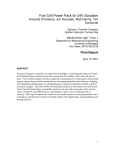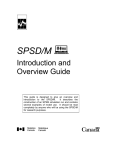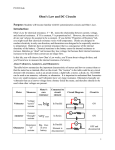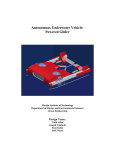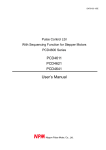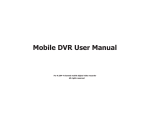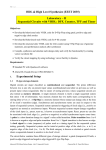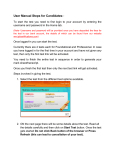Download Final Paper
Transcript
Hydrogen Fuel Cell Technology Leslie Daniels EME 6930 Description of the Client The client for this product would be ExploreLearning, a company that offers online access to simulations that support inquiry learning in math and science. This company develops "gizmo" simulations for students in grade levels third to twelfth grade. The company has received numerous awards for its research‐based curriculum. Typically, in order for students to gain access to their online simulations, an account representative contacts the school technology representative to determine the goals of the school and district. Based on the information obtained in this interview process, a proposal is made for delivery of their products and pricing. Statement of Problem Middle school teachers of physical science have limited resources to adequately teach the process of electrolysis. In the past, teachers may have had access to a Hoffman apparatus to demonstrate the process of splitting water into its component elements of hydrogen and oxygen to visualize the 2 to 1 ratio of its molecular structure, however, with budget constraints, few middle school science teachers would find this demonstration device in their science hardware inventory. Even if one could be located, the functionality of the instrument would be in question due to the sensitive platinum electrode it contains. If the instrument is not handled with care this component is easily damaged. The replacement cost of $70 would be weighed against other purchases. The development of a Flash simulation‐learning module would offer a cost effective alternative. Understanding the process of electrolysis is important for a number of science applications, particularly as it applies to the functioning of hydrogen fuel cell technology. In a time when all possible alternatives to carbon based fuel technology are being review and considered in relation to global warming and a taxed global economy, it is important that students understand what options might be offered with hydrogen fuel cell technology. When citizens are informed, they are able to make intelligent decisions about investment in alternative technologies. Understanding how a few cell works would help a student make a cost to benefit decision on the use of this technology. Hydrogen Fuel Cell Technology Leslie Daniels EME 6930 Target Audience The target audience is middle school science students. Although the concept of energy can be woven into any middle school science curriculum, it is generally a focus of a physical science curriculum. Physical science can be taught at any grade level from sixth through eighth, but generally it is taught in the eighth grade curriculum. Students in this age group are beginning to transition from concrete learning to more abstract learning capabilities. Science by nature is fairly abstract in terms of understanding many of its underlying principles. A curriculum at this age is more effectively delivered when student's learning is supported by a variety of activities that present the material in various learning modalities. Students at this age level need to be challenged. However their learning needs to be facilitated and supported in order for them to have the opportunity for success. When students are successful in the learning of abstract concepts, their confidence grows. By developing confidence in learning, students are prepared to meet the challenges of high school, which seeks to foster a more independent level of learning. Simulations are categorized in Bloom's taxonomy as higher order thinking skills. When students are successful in tasks at this level, their transition to independent learning is more likely to occur. The social development of students at this age level is often marked by traumatic conflicts with peer and family groups. Peers become a dominant factor in influencing behavior. Learning activities that are active and that involve the collaborative participation of peers is favored over passive learning. Since middle school students are fairly egocentric at this age, learning opportunities in which students can argue to convince others can be effective. Some of the angst of these years is driven by the marked physical changes that occur during adolescence. Students experience an accelerated period of physical development noted by increasing height, weight, heart size, lung capacity and muscular strength. Girls and boys vary in the rate of puberty development; boys tend to lag behind girls. Adolescents are often disturbed by these changes as they struggled to fit in with their peers. With all the changes that are occurring during this time period students have many factors that can put them at risk psychologically, physically and socially. Goals for the Target Audience The goal for the target audience is to be able to demonstrate their understanding of how the process of electrolysis applies in the energy transformations that occur in driving fuel cell technology. By manipulating the components of this process, namely hydrogen, oxygen atoms and water molecules, the students will simulate the process of electrolysis. From this level of understanding, students can then attempt the higher order thinking skill of synthesis in providing a recommendation regarding the viability of hydrogen fuel cell technology in solving key energy concerns of the future. Hydrogen Fuel Cell Technology Leslie Daniels EME 6930 Task Analysis / What the application will do Task Analysis: Students will need to understand the steps in the electrolysis of water process: • • • • Direct current from a battery source is passed through water Salts or acid is often added to the water as a catalyst in the reaction. The addition of salts or acid releases mobile ions and produces and electrolyte solution Platinum electrodes placed in the electrolyte solution will cause the hydrogen ions to migrate to the cathode electrode and oxygen ions to the anode electrode resulting in the decomposition of water into its molecular components of hydrogen and oxygen. The decomposition rate is at a 2:1 ratio, 2 atoms of hydrogen are produced to 1 atom of oxygen. The learning module will first review the components of the fuel cell system. The task the student will have is to recreate the events that occur in this system resulting in the generation of power and the recycling of water. Through a drag and drop process, the student will demonstrate their understanding of migration of negatively charged ions to the anode, positively charged hydrogen ions pass through the PEM membrane to the cathode. A circuit is created in the process. The functionality of this circuit will be demonstrated by the lighting of an electric bulb. The hydrogen electron then combines with the oxygen atom and positively charged hydrogen proton to form water, which is then recycled through the system. Students will be assessed through a short quiz to note their understanding of the chemical transitions that occur in the electrolysis process which result in the production of electrical power. Prerequisite Skills The intent of this learning module is to complement what has been previously taught to students on the topic of energy transformations. Since simulation is a higher order thinking skill, it would need to be presented after a basic level of understanding of energy transformations has been established. This basic understanding would be initially developed through guided inquiry at a more fundamental level. This guided inquiry would incorporate hands on activities to aid the students form an understanding at a more concrete level. Some key concepts that would be foundational to this learning module would be the following: • • • • Students would need to know that energy is neither created nor destroyed but only converted from one form to another. Students would need to have a basic understanding of the atom. Students would need to be able to distinguish between an element and a molecule. Students will need to know about migration of positive and negative ions to anode and cathode terminals as in the operation of a battery. Hydrogen Fuel Cell Technology Leslie Daniels EME 6930 • Students will need to know how a circuit functions. Technical Requirements to Create the Application The technical requirements are the following (Mac Version): • • • • • • • • • • • • • • • I GHz PowerPC G4 or G5 or multi‐core Intel processor Mac OS X v.10.4.8 512MB of RAM (1 GB recommended) 2.5 GB of available hard‐disk space (additional free space required during installation) 1,024 x 768 monitor resolution with 16‐bit video card DVD‐ROM drive QuickTime 7.1.2 software require for multimedia features Internet or phone connection required for product activation Broadband Internet connection required for Adobe Stock Photos and other services Flash development software (CS3, CS4) Flash Reader to read swf files Audio file editor (Audacity, GarageBand) Speaker system Microphone iMovie editor Technical Requirements for Learner to Use Application (Mac Version) • • • • • • • Access to the Internet Browsers Mac OS (Firefox 2.x or 3.x, AOL for Mac OS X, Opera 9.5, Safari 3.x) Mac Platform Only: Mac OS X V10.4 or 10.5 128MB of RAM and 128MB of VRAM 500MHZ PowerPC G3 or 1.33GHz Intel Core duo processor Adobe FlashPlayer10 plug‐in Account with Explorelearning Hydrogen Fuel Cell Technology Leslie Daniels EME 6930 Design Component Instructional Objectives The student will identify the components of the electrolysis process. The student will describe the energy conversions that take place in the electrolysis process. • The student will reconstruct the events that occur in the hydrogen fuel cell. • The student will examine the role electrolysis plays in the production of hydrogen fuel. • The student will evaluate the efficacy of hydrogen fuel production as an alternative to a petroleum fuel based economy. The competency the student can expect to gain from the learning module on hydrogen fuel cell technology is an understanding of mechanics used to generate hydrogen fuel. Students will see that energy is required to split water into its component parts, hydrogen and oxygen. This in fact is considered a cost when evaluating the prospects of using hydrogen fuel as a source of energy. A benefit the students will see is that the process is relatively pollution free, as the product is water. Understanding the cost and benefits of this technology is useful in making decisions about the use of this energy source. • • Prerequisite Skills and Knowledge Understanding the process electrolysis plays in generating hydrogen fuel requires and understanding of several foundational concepts. First, students should know that energy comes in many forms: electrical, chemical, radiant, thermal and so on. Although energy comes in a variety of forms, students should know it is conserved. In other words, as it relates to the Law of Conservation of Energy, “Energy can not be created, nor destroyed. It is only converted from one form to another”. Students also need to have a foundation in atomic structure. They should know that the atom is made up of protons, neutrons and electrons. The relative charges for each of these subatomic particles should also be understood, i.e., protons have a positive charge, neutrons are neutral in charge and electrons have a negative charge. With an established understanding of atomic structure, students can build on there knowledge of chemical principles. Atoms combine to form substances. These substances can be pure as is the case of elements, compound as in the case of molecules and compounds or mixtures, both homogeneous and heterogeneous. Water is a molecule. Water can be split into its elemental components, hydrogen and oxygen. This process requires energy. It is a decomposition reaction. In the process of electrolysis, electricity is used to split the water molecule. Hydrogen Fuel Cell Technology Leslie Daniels EME 6930 Students should know that electricity is the net flow of electrons from an area of high concentration to one that is lower. The basics of electrical circuitry are foundational to understanding how when the hydrogen ion is split into its positive and negative components, namely one proton and one electron, an electromagnetic potential is created. The electrons then flow through a wire establishing a circuit. A load can be placed on circuit and the energy can be tapped and put to use as in the powering of a machine or lighting a light bulb. The role the battery plays in terms of providing a voltage potential is also important. Several key concepts, drawing from both an understanding of physics and chemistry principles, need to be linked in order to understand the mechanics of a hydrogen fuel cell. Even though it seems simple enough, water is split into hydrogen and oxygen, the hydrogen is used as a fuel, this is a fairly complex process for middle school students to fully understand. Visual representation of this process coupled with a narrative description is a multimedia approach that could be effective in facilitating an understanding. Instructional Strategies The instructional strategies will be primarily guided inquiry. First a foundation of understanding needs to be established. In order to engage the learner of this age group, guided inquiry will capture their natural curiosity. Using this framework to build the foundational basics described earlier as the prerequisite skill base, students will review the basics through a series of “hands on activities”. For example, to determine their understanding of atomic structure, a student would be asked, “Given the subatomic particles of an atom, (electron, proton, and neutron), drag representative illustration of each, to the area you would find them in the atom.” Feedback could be provided, if a student needs more guidance. After the basics are reviewed, the process of electrolysis can be introduced. The learning strategy will continue to be guided inquiry with the posing of questions. When presented with a Hoffman apparatus illustration showing the displacement of water ratio of 2:1 in the cylinder, the students could predict which one is hydrogen and which one is oxygen. This process would continue and the process of electrolysis would be constructed by presenting each component in the process and predicting the role it plays. Finally, the application of the process of electrolysis to the mechanics of the fuel cell will be illustrated. Students again could predict how the fuel cell might function and then the process would be reviewed through animation and narration of the key steps in the process. Instructional Strategies Since so many concepts need to be linked to fully understand the mechanics of a fuel cell, concept mapping will be use to build the connections between the physical and chemical concepts that interplay in a fuel cell. Additionally, questions can be posed to the students to check for their understanding at critical points in the learning process. Finally, students can evidence their Hydrogen Fuel Cell Technology Leslie Daniels EME 6930 understanding of how a fuel cell works through a drag and drop game sequence in which they simulate the process of generating fuel and power in the operation of a fuel cell. Constraints and Limitations The instructional strategies I would employ come with their own set of constraints. When attempting to develop student independence in learning, it is possible to not provide enough guidance to support the learner’s development. The inquiry method is appropriate in science as it models the process of science itself and builds on a student’s natural curiosity. However, students schooled with a more traditional approach in which the teacher is the giver of all answers, can be easily frustrated when the answer isn’t apparent. Providing feedback and guiding the student based on their responses, can alleviate some of this anxiety. The approach I have described requires a lot of visual animation and guidance as well as narration. Animations and simulations are time‐consuming and expensive to produce. However, in the long run they can be cost effective in a science setting because they can replace the cost of expensive equipment. This project would require a team of at least two to three designers to develop all the animations and simulations and audio files described. Each would need to be proficient in Flash animation, web design and audio and video editing. At least one would need to be a content expert to verify the accuracy of the information. Scope of Project This project would fit into a unit on energy. Energy is a very large topic in science; it essentially flows through virtually every field of science, earth science, life science, chemistry and physics. However, the focus of this energy unit would be primarily in chemistry and physics. My project piece will be the simulation of the fuel cell functionality. As such, it would be best placed at the end of a unit on energy since so many foundational concepts need to be constructed before the mechanics of a fuel cell can be understood. While simulations foster higher order thinking skills, being able to evaluate and support a position on a topic is considered the highest level in Bloom’s Taxonomy. The scope of this project is to guide the student in understanding the underlying processes that are used in the function of a fuel cell. From this understanding, students can derive the risks and benefits and even the economic feasibility of this technology. Essentially this project would support the development of an informed citizenry who vote and decide whether to support research and development of this technology. List of Deliverables • • • Prototype of an hydrogen fuel cell simulation a part of a larger unit on hydrogen fuel cell technology User guide Final Proposal Paper Hydrogen Fuel Cell Technology Leslie Daniels EME 6930 Media Use The media will be a Flash movie clip in which sound elements are incorporated. Also a narrative of the process will be included. Style Guide Text Elements: Verdana 12 pt. Headings 16pt. Color: Black, Bold Color Elements: Background: White Graphic Elements will be of contrasting colors to provide emphasis Hi‐Level Flow Chart Introduction Energy Module Menu Menue Atomic Structure Chemical Bonding Electricity & Circuits Electrolysis Hydrogen Fuel Cell Technology Hydrogen Fuel Cell Technology Leslie Daniels EME 6930 Citations Instructional Strategies Online, retrieved on June 5, 2009 from http://olc.spsd.sk.ca/DE/PD/instr/index.htm How Fuel Cells Work, retrieved on June 5, 2009, from http://auto.howstuffworks.com/fuel‐efficiency/alternative‐fuels/fuel‐cell.htm Electrolysis of Water, retrieved on June 5, 2009, from http://hyperphysics.phy‐astr.gsu.edu/Hbase/thermo/electrol.html Hydrogen Fuel Cell Technology Leslie Daniels EME 6930 Development Paper – Flow Charts (High and Low Level) Hydrogen Fuel Cell Technology Leslie Daniels EME 6930 Hydrogen Fuel Cell Technology Leslie Daniels EME 6930 Hydrogen Fuel Cell Technology Leslie Daniels EME 6930 Hydrogen Fuel Cell Technology Leslie Daniels EME 6930 Hydrogen Fuel Cell Technology Leslie Daniels EME 6930 Storyboards Hydrogen Fuel Cell Technology Leslie Daniels EME 6930 Storyboards Continued: Hydrogen Fuel Cell Technology Leslie Daniels EME 6930 Storyboards Continued: Description of Interactivity The interactivity elements contained within this learning module occur both within the lesson itself and within the assessment component. Within the application, the user can freely navigate to the lesson of interest within the learning module, although the general arrangement of the instructional design is from the beginning foundational concept of atomic structure sequentially to fuel cell technology. This enables the user to review any of the lesson components at any time within the lesson. The user can also freely navigate within each lesson component through the use of previous and next buttons and return to main menu. Interactivity is also designed when the user reviews the video on the process of electrolysis. The controls on the video allow for starting and stopping. The user also gets an indication of the duration of the video with the elapsing of the progress bar. Additionally, the user can adjust the sound. In the assessment component, the user is able to move freely from item to item at their own pace. There is also the option to return to the previous question if desired. One of the assessment procedures allows for students to select the correct response through a drag and drop feature. Description of Assessment Procedures The assessment procedures are varied to allow the user different opportunities to evidence their understanding of the content. One assessment option is through a multiple‐choice quiz. Students can select their answer to the question posed and then check their answer for immediate feedback. At the end of the multiple‐choice quiz students get a final score assessment as well as an indication of the time it took to complete the quiz. A second option for students to evidence the understanding of the Hydrogen Fuel Cell Technology Leslie Daniels EME 6930 content is through a drag and drop activity. In the activity, the student selects the correct answer and then drags it to a specific location on the stage. At that point the student will receive specific feedback as to the correctness of their answer. A final assessment approach is through the use of an open‐ended question and response. In this format the student will input their answer into a text‐box and then compare their answer with the feedback that is given upon submission. This final assessment component will be part of the circuitry section that is still in development. Specific Description of Feedback The feedback to the user is designed to be immediate. When the user selects an answer in the multiple‐choice quiz, the option to immediately check the answer is provided by a check answer button. Clicking on this button displays feedback indicating to the user the correctness of the response. Also at the end of the multiple‐choice quiz, feedback is immediately provided in terms of the overall performance and the time it took to complete the quiz. In the drag and drop assessment, feedback is immediate and also instructional. If the user selected the incorrect answer, feedback is given as to why the answer is incorrect. Specific Multi‐media File Links A variety of multi‐media components are used in the learning modules. The image elements obtained from the creative commons resource are as follows: Retrieved from http://drbein.net/chemistry.htm Retrieved from https://eapbiofield.wikispaces.com/Water+Science+KA Hydrogen Fuel Cell Technology Leslie Daniels EME 6930 All of the above car images were retrieved from http://hackedgadgets.com/2007/04/23/hydrogen‐fuel‐ cell‐rc‐car/ Retrieved from http://www.princeton.edu/~chm333/2002/spring/FuelCells/fuel_sources.shtml Retrieved from http://superphysics.netfirms.com/pp_electricity.html All of the other images in the learning module were draw using tools in the Flash interface. Hydrogen Fuel Cell Technology Leslie Daniels EME 6930 Video components: The video on the electrolysis process was retrieved from http://video.google.com/videoplay?docid=2058430501024193438&ei=zA1hSvmVM5aOqQLloegn&q=el ectrolysis&hl=en All of the other movie clips used in this learning module were developed by using the tools available within the Flash interface. Navigational Branching Within this learning module on fuel cell technology there are several options for navigation. These navigational elements are described as follows: Previous ‐ this button will take you to the previous page or if you are within the multiple‐choice quiz, you will be taken to the previous question. Next – this button will take you to the next page. If the user clicks on the next button within the multiple‐choice quiz, the user will be directed to click on a response to the posed question before proceeding. Quiz – this button alerts the user that upon clicking, it will take the user to an assessment component. Return to main menu – this button when clicked will take the user to the main menu navigation page. Facilitator Guide/User Manual Currently this resource is not available. Learner Materials/Handouts Currently this resource is not available.






















